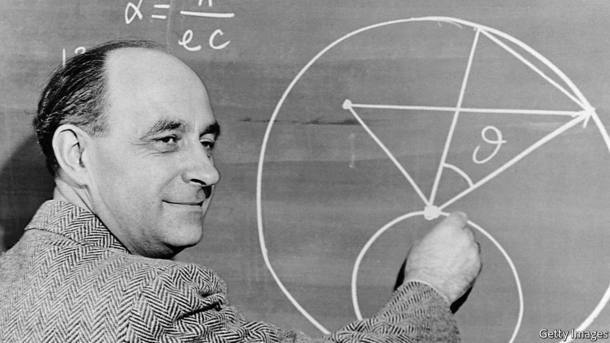Fermi theory of beta decay
In particle physics, Fermi's interaction (also the Fermi theory of beta decay) is an explanation of the beta decay, proposed by Enrico Fermi in 1933. The theory posits four fermions directly interacting with one another (at one vertex of the associated Feynman diagram). This interaction explains beta decay of a neutron by direct coupling of a neutron with an electron, a neutrino (later determined to be an antineutrino) and a proton.

When a nucleus turns into a different nucleus emitting an electron or a positron (positive charged particle with the same mass as the electron), we say that nucleus has undergone a beta decay. Like alpha decay, it is a spontaneous process, with a well-defined energy of disintegration and half-life. Beta decay is a statistical process. There are three different types of beta decay: beta negative, beta positive and electron capture.
In the negative beta: what decays is an electron that is the transformation of a neutron (n) into a proton (p) along with an electron (β-) and an antineutrino (ve). "Negative beta decay can occur when the atomic mass of the original neutral atom is greater than the corresponding mass of the final atom."
n → p + β- + ve
In positive beta: It can happen when the difference enters the atomic mass of the original atom and the atomic mass of the final atom is greater than twice the mass of the electron.
p → n + β+ + ηe
Transformation of the proton (p) into neutron (n) plus a positron (β +) and an electron neutrino (ηe).
Electron capture beta decay: can occur when the atomic mass of the original neutral atom is greater than the mass of the final atom.
There are nuclides for which positive beta decay is not energetically possible, but an orbital electron can combine with a proton of the nucleus, giving rise to a neutron and a neutrino, the neutron remains in the nucleus and the neutrino is emitted.
p + β- → n + ηe
Fermi first introduced this coupling in his description of beta decay in 1933. The Fermi interaction was the precursor to the theory for the weak interaction where the interaction between the proton–neutron and electron–antineutrino is mediated by a virtual W−boson.
Fermi first submitted his "tentative" theory of beta decay to the famous science journal Nature, which rejected it "because it contained speculations too remote from reality to be of interest to the reader. Nature later admitted the rejection to be one of the great editorial blunders in its history. Fermi then submitted revised versions of the paper to Italian and German publications, which accepted and published them in those languages in 1933 and 1934. The paper did not appear at the time in a primary publication in English. An English translation of the seminal paper was published in the American Journal of Physics in 1968.
English translation of Fermi's paper on β-decay.Fermi found the initial rejection of the paper so troubling that he decided to take some time off from theoretical physics, and do only experimental physics. This would lead shortly to his famous work with activation of nuclei with slow neutrons.
Treating the beta decay as a transition that depended upon the strength of coupling between the initial and final states, Fermi developed a relationship which is now referred to as Fermi's Golden Rule:

Straightforward in concept, Fermi's Golden Rule says that the transition rate is proportional to the strength of the coupling between the initial and final states factored by the density of final states available to the system. But the nature of the interaction which led to beta decay was unknown in Fermi's time (the weak interaction). The nature of that model in terms of the distribution of electron momentum p is summarized in the relationship below.




REFERENCES
HyperPhysics, Georgia State University. Available in: http://hyperphysics.phy-astr.gsu.edu/hbase/quantum/fermi2.html. Access in: 30/09/2018.
Wikipedia. Available in: https://en.wikipedia.org/wiki/Fermi%27s_interaction. Access in: 30/09/2018.
Encyclopaedia Britannica. Available in: https://www.britannica.com/science/beta-decay. Access in: 30/09/2018.


























0 comments
Sign in or create a free account